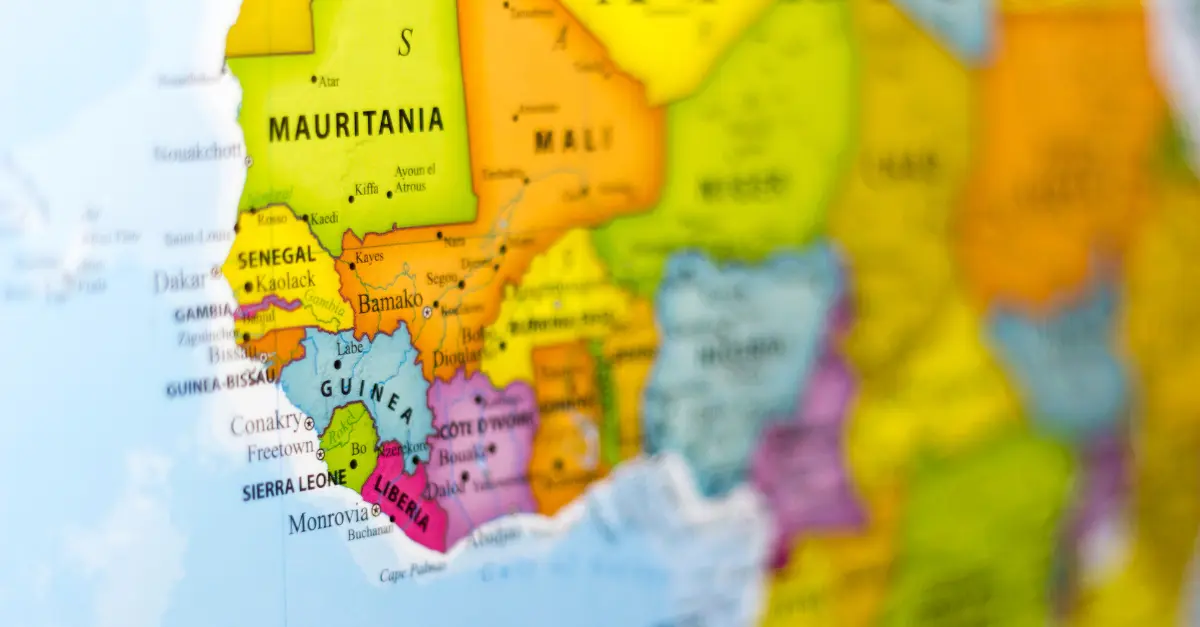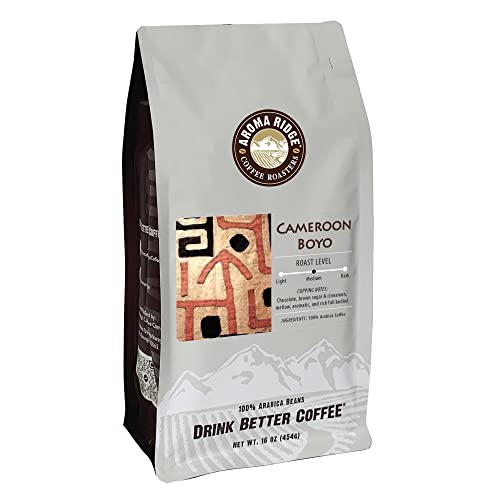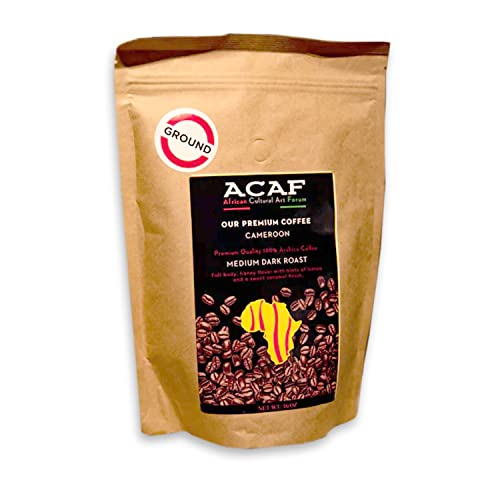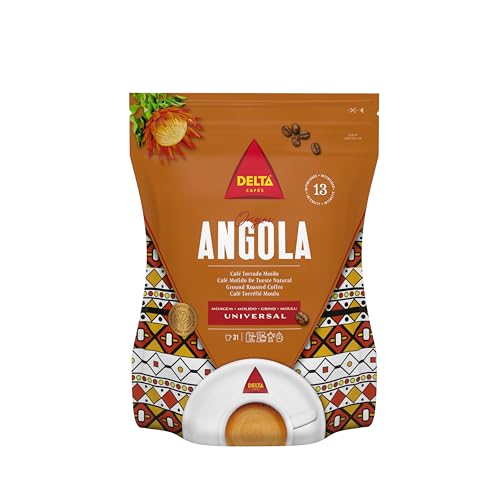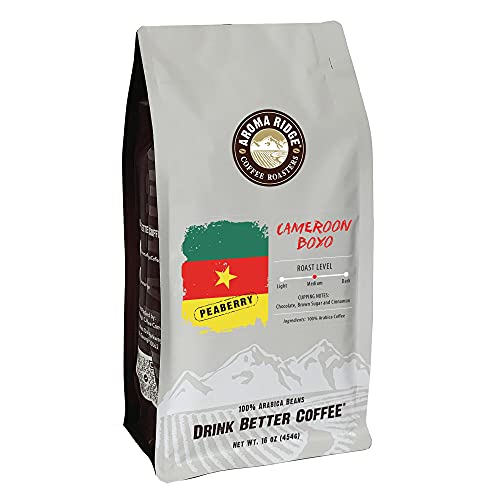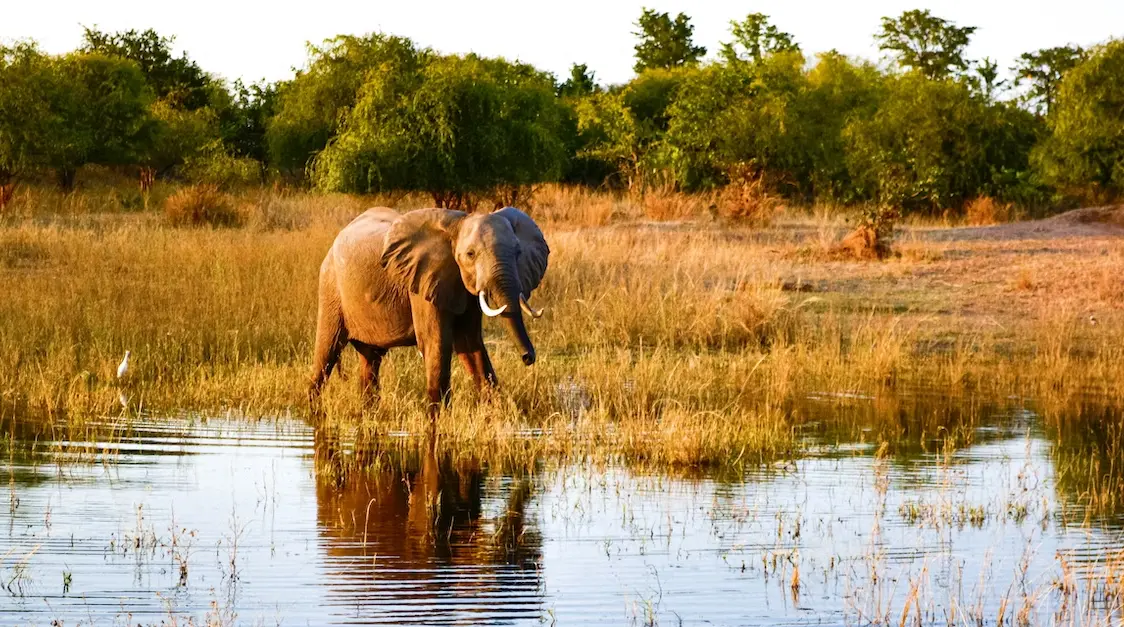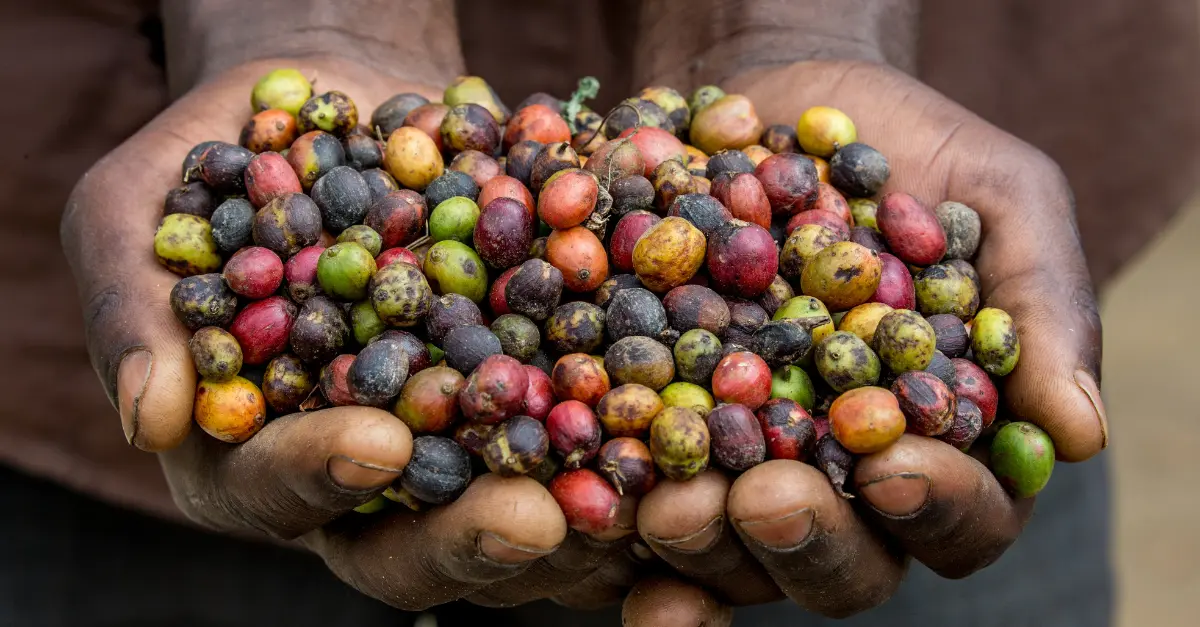Did you know that West African coffee is equally sought after as its Eastern region’s counterpart? For many coffee drinkers, Arabica coffee from Ethiopia and Kenya, or Robusta coffee from Uganda and Tanzania, is a more common encounter.
Many coffee drinkers believe that coffee from Africa simply comes from Eastern African countries, like Ethiopia, Rwanda, Burundi, and DRC, among others. However, several West African countries are equally significant coffee producers in the region.
West African countries, such as Cote d’Ivoire and Cameroon, are among the largest robusta coffee producers after Uganda. Are you curious about this lesser-explored part of African coffee production? Here’s an in-depth guide to everything West African coffee.
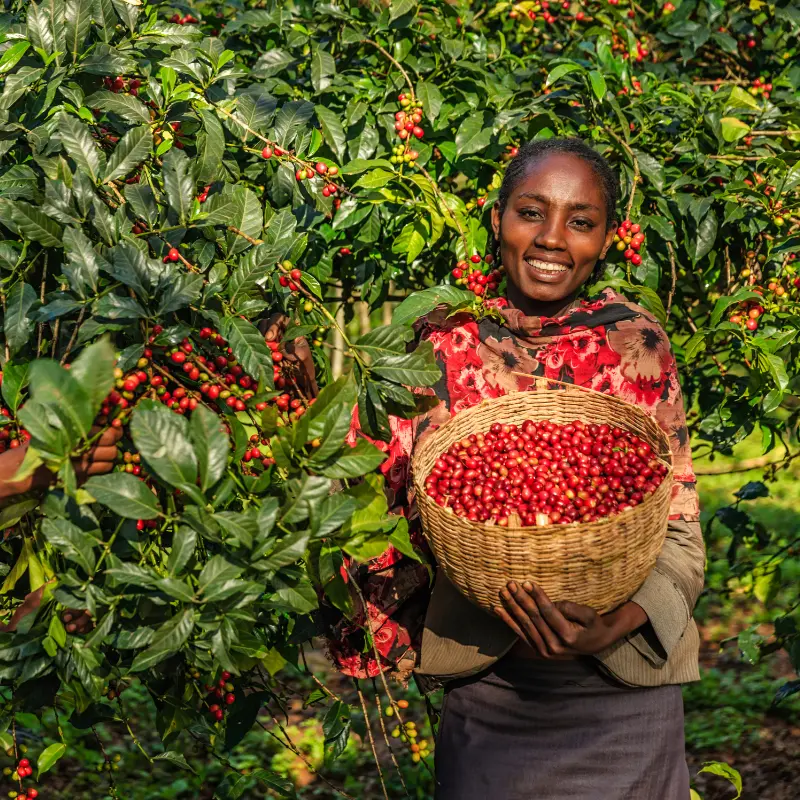
Try the Best West African Coffee Beans on the Market Today!
Retail West African coffee can be elusive and hard to understand. However, this doesn’t mean it is entirely unavailable on the market. With the right research, you can get a few excellent options. You can find many roasters online that sell select coffee from various West African countries.
Featured Products
Aroma Ridge Cameroon Boyo Coffee
⭐ 4.2/5 • 💰 ~$23
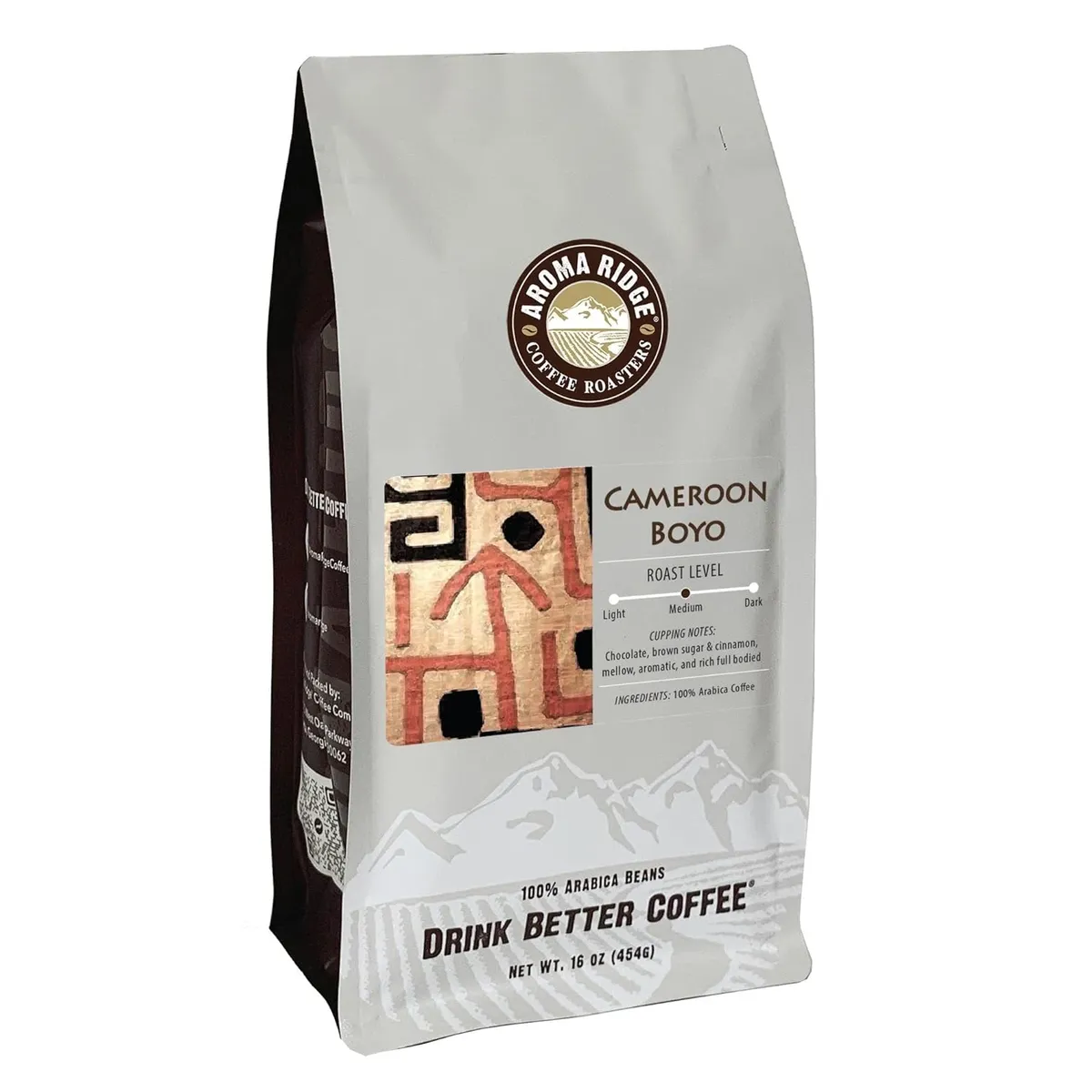
The Aroma Ridge Cameroon Boyo is a distinct flavored coffee with handpicked beans from fertile volcanic soils.
Pros:
- Beans are handpicked from fertile volcanic soils
- Offers a distinct flavor journey
- Whole beans for freshly ground coffee at your convenience
Cameroon Premium Coffee
💰 ~$28
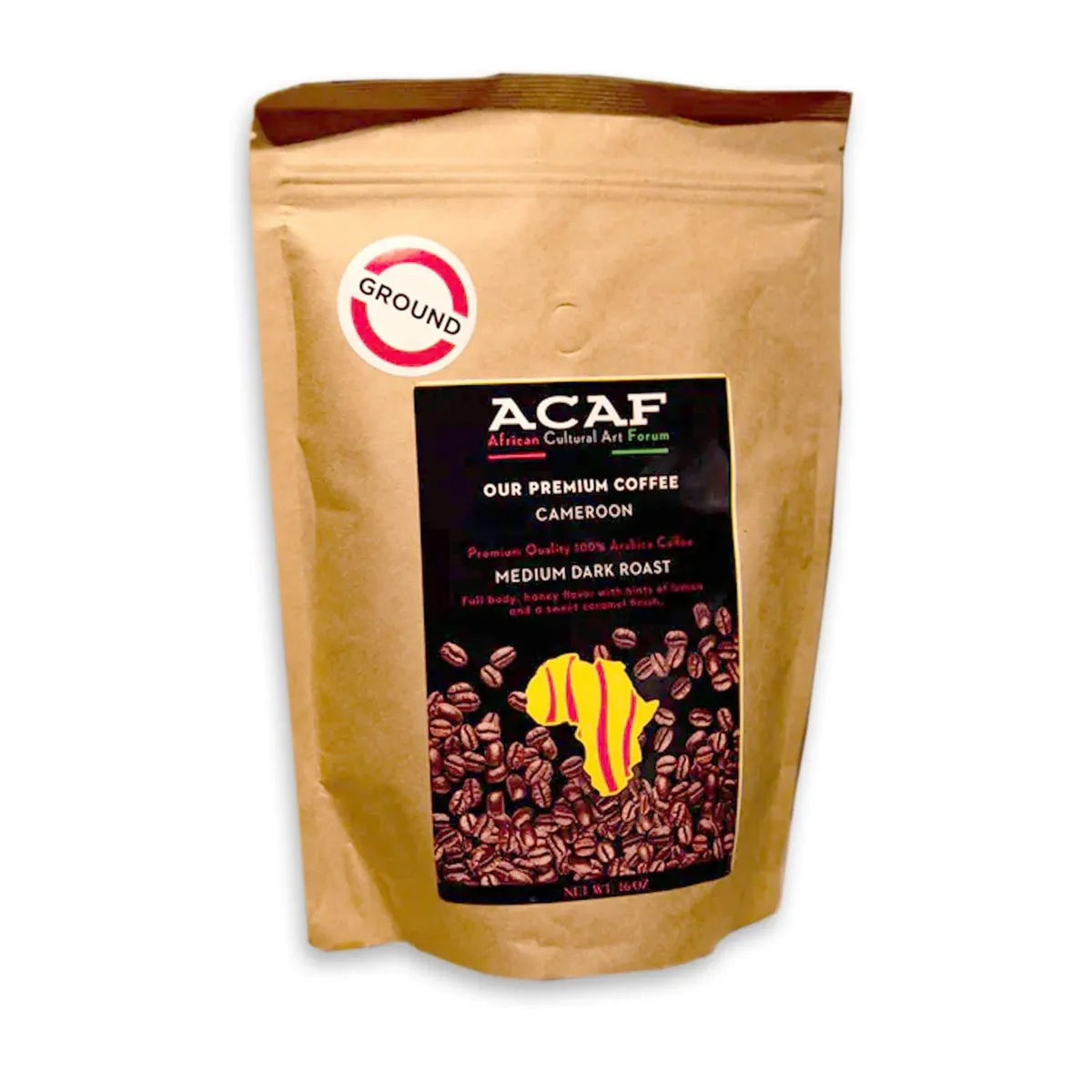
African premium medium-dark roast coffee from the OKU valley, West Africa. A unique blend of flavors with a taste of home.
Pros:
- Premium quality 100% arabica
- Unique blend of flavors with hints of lemons and caramel
- Represents African origin beautifully
- Available in both ground and whole bean form
Delta Ground Roasted Coffee from Angola
⭐ 4.4/5 • 💰 ~$14
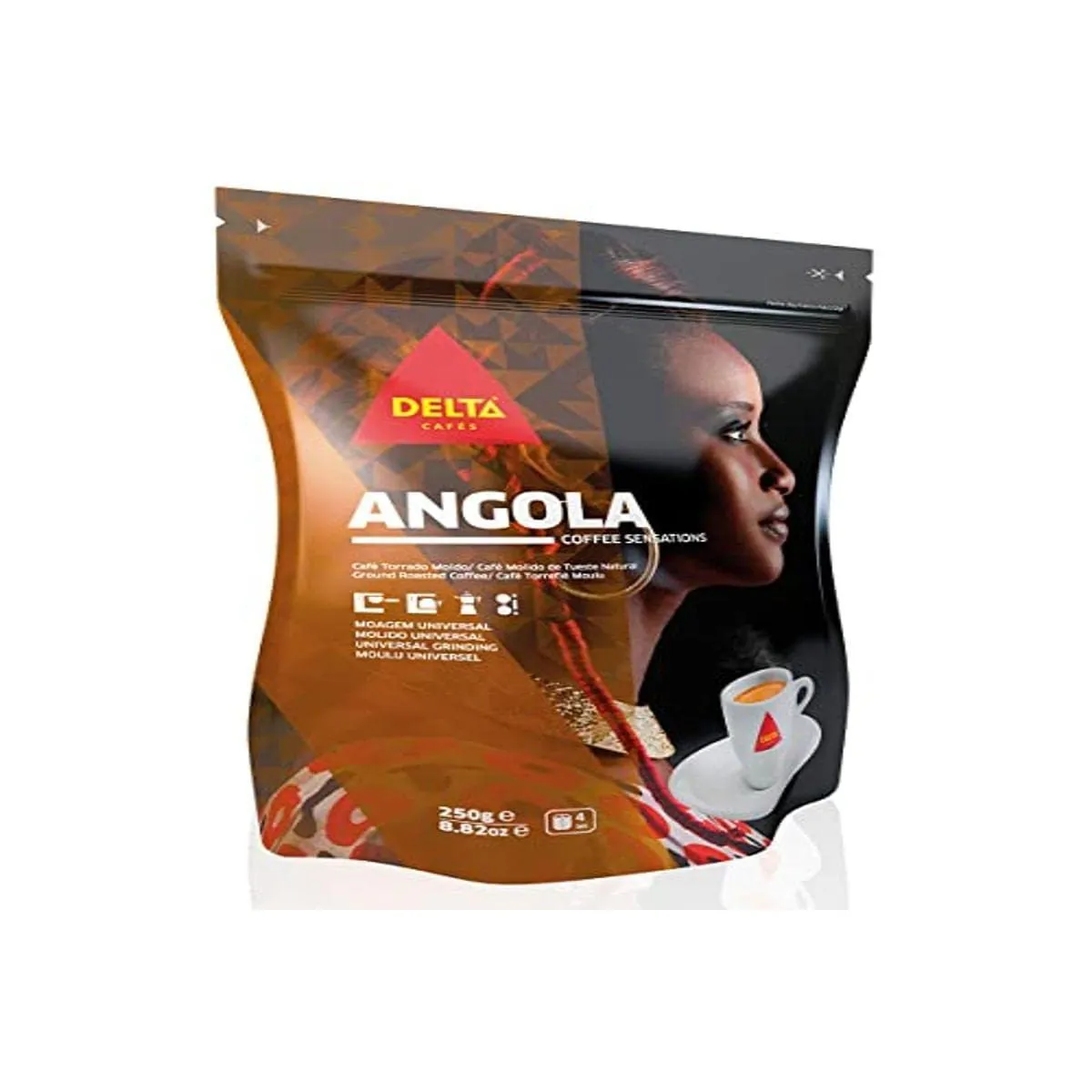
Delta Cafes Angola uniquely blends high-quality Angolan coffee, offering a drink full of character and African flair.
Pros:
- Offers a distinctive character and strength
- Blended from the best Angolan coffees
- Incorporates subtle nuances and notes of African soul
Aroma Ridge Cameroon Boyo Peaberry Coffee
⭐ 4.3/5 • 💰 ~$23
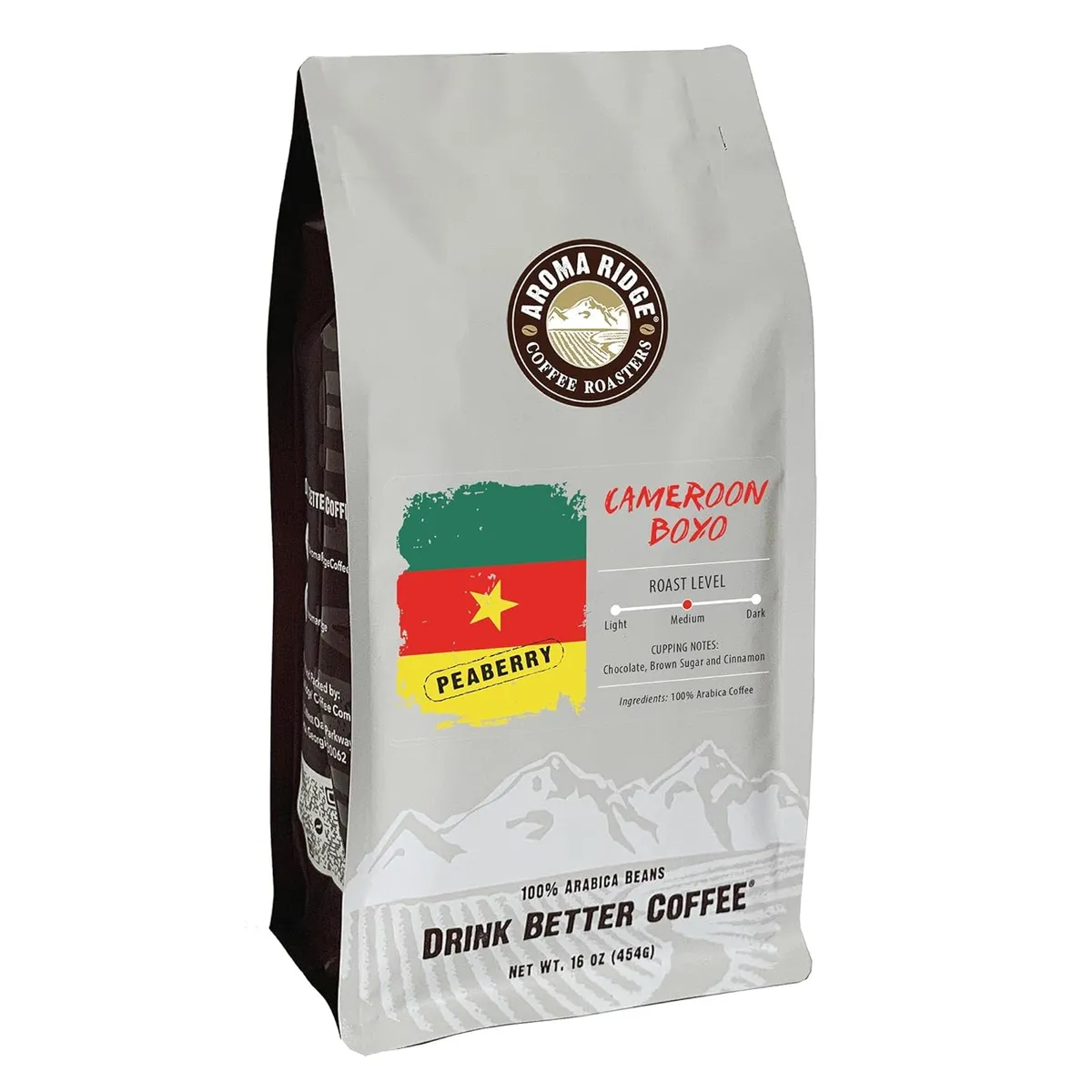
Premium quality coffee, freshly roasted in the USA offering a unique, rich flavor.
Pros:
- Provides a unique taste
- Freshly roasted in the USA
- Whole beans ensure a fresh flavor
- Perfect for coffee lovers
West African Coffee Facts
- By the 1970s, Cote d’Ivoire was the third-largest coffee producer globally and Africa’s largest coffee producer.
- Cote d’Ivoire is Africa’s third-largest coffee producer – and West Africa’s largest producer!
- Cote d’Ivoire enjoys 13% of Africa’s coffee market share – behind Ethiopia and Uganda
- Cote d’Ivoire is the second-largest producer of Robusta Coffee in Africa
- Coffee production in Cote d’Ivoire significantly decreased in the past 20 years due to civil war
- Cameroon accounts for 3% of Africa’s coffee market share
- Guinea’s Macenta-Ziama varietal is the most sought-after robusta variety due to its smoother and sweeter profile (comparable to Arabica)
- Guinea grows Liberica coffee (but not commercially) as it borders the native home of the coffee variety (Liberia)
- Nigeria is a large consumer of instant coffee (Nescafe produced in Cote d’Ivoire)
- Liberica coffee varietals are native to Liberia, although Malaysia is the largest producer today
West African Coffee: Coffee-Producing Countries
Most coffee-producing countries in West Africa produce robusta coffee, although some cultivate other varieties. Like many other East African countries, the West African country, Cameroon, has robusta and some arabica.
On the other hand, Liberia produces Robusta and Liberica. Interestingly enough, the Liberica varietal is native to the country, but only 5% is made in Liberia. Still, like other West African countries, robusta is the primary coffee variety produced in Cameroon.
Coffee production in West Africa happens in 9 countries. These include;
- Côte d’Ivoire
- Cameroon
- Togo
- Guinea
- Nigeria
- Ghana
- Sierra Leone
- Burkina Faso
- Liberia
- Benin
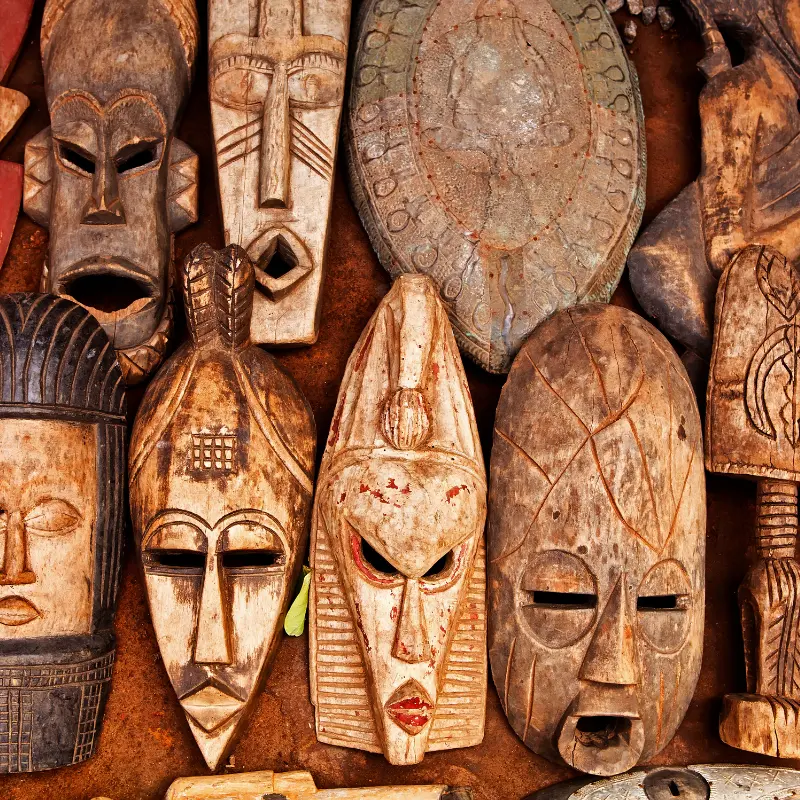
1. Ivorian Coffee
- Country: Cote d’Ivoire/Ivory Coast
- Growing regions: Abboisso, Abengorous, and Divo
- Coffee varieties: 100% Robusta and Arabusta
- Processing: Natural
- Profiles: Earthy and bitter flavor with coarse texture
- Average production: 238 million pounds (1.2% of the total global coffee production)
- Harvest season: August to January
Cote d’Ivoire produces coffee as one of its crucial cash crops, along with cocoa. While it ranks 14th globally for coffee production, Cote d’Ivoire is the 3rd largest coffee producer in Africa and West Africa. However, the country exclusively grows robusta coffee due to its geographical setting.
Unlike Ethiopia, Kenya, and Tanzania, with a mix of highland regions, Ivory Coast doesn’t offer such high elevations and altitudes to accommodate the cultivation of arabica coffee. Robusta coffee is also more forgiving at relatively higher temperatures and resistant to pests and diseases. So, not much care or special conditions are needed for it.
Still, robusta coffee requires specific conditions, with elevations that are not too low and temperatures that aren’t too high. In Côte d’Ivoire, robusta coffee grows at a height of about 980 to 1,300 feet above sea level and temperature of about 64 to 94 degrees Fahrenheit. Moreover, coffee-growing regions in Cote d’Ivoire receive about 3000 mm of rainfall annually.
Coffee in Cote d’Ivoire grows in the regions of Abboisso, Abengorous, and Divo. These regions lie at 980 feet to 1,310 feet above sea level – perfect for cultivating robusta coffee varieties.
French colonizers introduced coffee in Cote d’Ivoire in the 19th century. The production of this crop continues to grow immensely, with coffee produced primarily for export. By the mid-20th century, Ivory Coast had become the top 3 producer of coffee globally. During this time, Cote d’Ivoire even claimed its position as the largest coffee producer in Africa!
Unfortunately, due to frequent civil wars since 2000, coffee production in Ivory Coast has faltered in the past 20 years. Nonetheless, the country holds the top 20 position globally. The country will eventually recover and gradually claim its place among the top producers of coffee worldwide.
Coffee from Cote d’Ivoire is usually mass-exported as green coffee beans. Yet, it is difficult to sample retail coffee from the country. This is because coffee is generally exported as raw material for creating coffee-based products. These include adding the coffee to espresso blends or creating instant coffee mixes.
So, you have tried Ivorian coffee without really knowing it. In very rare cases, you can purchase Ivorian coffee in the form of green coffee beans to roast and grind yourself to sample the coffee as a single origin truly. Today, the majority of buyers of mass-export coffee are from the Netherlands, USA, France, Italy, Germany, Japan, Canada, and the UK.
After harvest, coffee is naturally processed, a more realistic and sustainable process due to the limited water supply in the region. Unfortunately, natural processing requires great detail and attention to remove defective coffee beans.
This issue contributes to Ivorian coffee being of not–so–premium quality. Instead, it is primarily cultivated and exported as a filler or ingredient for other products. This means quality is not the most significant factor during harvest and processing.
Special Ivorian Coffee Variety
Cote d’Ivoire has been producing an exceptional coffee varietal since the 1960s. Arabusta is a hybrid blend of arabica and robusta varietals. The varietal boasts a clever mix of the benefits of these two varieties. It is easier to grow than arabica coffee and is much sweeter than robusta coffee.
It is also slow growing compared to robusta, allowing it to develop its flavors better. Nonetheless, Arabusta is still an experimental varietal, and more is needed to improve it to make it more mainstream and manageable.
2. Cameroonian Coffee
- Country: Cameroon
- Growing regions: West, Northwest, Littoral, Southwest, South, Center, and East
- Coffee varieties: 80**%** Robusta and 20% Arabica
- Processing: Natural
- Profiles: Rich, earthy, full, and nutty flavor (Robusta) Mellow chocolate, fruity, floral, and sweet(arabica)
- Average production: 75 million pounds (0.4% of the total global coffee production)
- Harvest season: September to December
Cameroon is the second-largest coffee producer in West Africa and the world’s 22nd-largest coffee producer. Cameroon produces less than half of what Cote d’Ivoire has but offers more variety. Cameroon makes about 80% robusta and 20% arabica beans – a near-corresponding difference to Tanzania’s majority arabica and some robusta cultivation.
Coffee has consistently grown in Cameroon, but it was commercialized, and its production was enhanced during the German colonial era in the late 19th century. More regions in Cameroon are better placed to grow coffee.
Most coffee is grown in Anglophone Cameroon in the North West and West regions. But, a few francophone French areas also grow coffee. The arabica variety is widespread across the western highlands, while robusta is commonly grown at lower altitudes with higher temperatures in the coastal areas. These include;
- West
- Northwest
- Littoral
- Southwest
- South
- Center
- East
- Adamawa
As mentioned above, arabica coffee is grown in the west and northwest Cameroonian regions. Of the arabica varieties grown in Cameroon, the more resistant Java, Typica, and bourbon arabica are more prevalent. Cameroonian arabica offers characteristic mellow, chocolatey, fruity, floral, and sweet flavors. On the other hand, robusta coffee is grown in coastal littoral, southwest, west, east, and Adamawa. Cameroonian robusta offers a more prosperous, earthier, fuller, and nutty yet balanced profile.
Like Ivorian coffee, Cameroonian coffee is naturally processed and exported as green coffee. The majority of consumers of Cameroonian arabica coffee are in Belgium, USA, Germany, and Italy, while the majority of the robusta is exported to France.
Cameroon is also among African countries with a growing coffee consumption among locals. Around 5% of the total coffee produced in the country remains and is locally roasted to be consumed. The biggest hurdle to coffee production in the country and its continual stagnation is government interference and minimal efforts to support and foster the industry. Poor resources, crop disease, and market competition also continue to impact the coffee industry in Cameroon.
3. Togolese Coffee
- Country: Togo
- Growing regions: Agou, Kloto, Danyi, Mou-Okposo, and Wawa
- Coffee varieties: 99**%** Robusta and 1% Arabica
- Processing: Natural and washed
- Profiles: Earthy and bitter (robusta) Sweet, fruity, and floral (Arabica)
- Average production: 24 million pounds (0.1% of the total global coffee production)
- Harvest season: September to December
Togo produces less than half of the total coffee made in Cameroon. The country’s agricultural sector plays a minimal role in its overall export earnings, accounting for just 30%. Of these agricultural exports, coffee exports only account for about 0.52%. Nonetheless, Togo ranks at 34 out of nearly 70 coffee producers globally by production scale.
Coffee production became significant in the early 20th century during French colonial rule. However, the country has maintained its status as a small coffee producer - with robusta being the majority varietal. Coffee in Togo is grown in the southwest regions of Agou, Kloto, Danyi, Mou-Okposo, and Wawa.
Southern regions have more mountainous terrain than northern ones, offering the perfect climate and conditions for growing coffee. Almost all coffee producers in Togo are small-scale and peasant farmers who grow the crop alongside cocoa.
This partly explains why production numbers have always remained low. With less effort put into the industry, aging coffee trees, declining demand for the crop, and labor shortages have continued to force the country’s coffee production to falter.
Other West African Coffee Coffee-producing Countries
West Africa’s largest coffee producers are Côte d’Ivoire, Cameroon, and Togo. But, they are not the only coffee-producing countries in the region. Other West African countries also produce coffee – exclusively robusta varietals.
However, these countries produce a much smaller quantity for export as ingredients for other products – like instant coffee mix or espresso. Some smaller countries have unique and interesting varietals, like Guinea’s Macenta Robusta or Liberia’s Liberica. These include;
4. Guinean Coffee
- Country: Guinea
- Growing regions: Ziama Massif, Eastern highlands, western highlands, and Simbu
- Coffee varieties: 100**%** Robusta
- Profile: Earthy and bitter (robusta), bright acidity, no bitterness, smoother and somewhat sweet (Ziama Macenta variety)
- Processing: Natural
- Average production: 21 million pounds (0.1% of the total global coffee production)
- Global rank: 35th
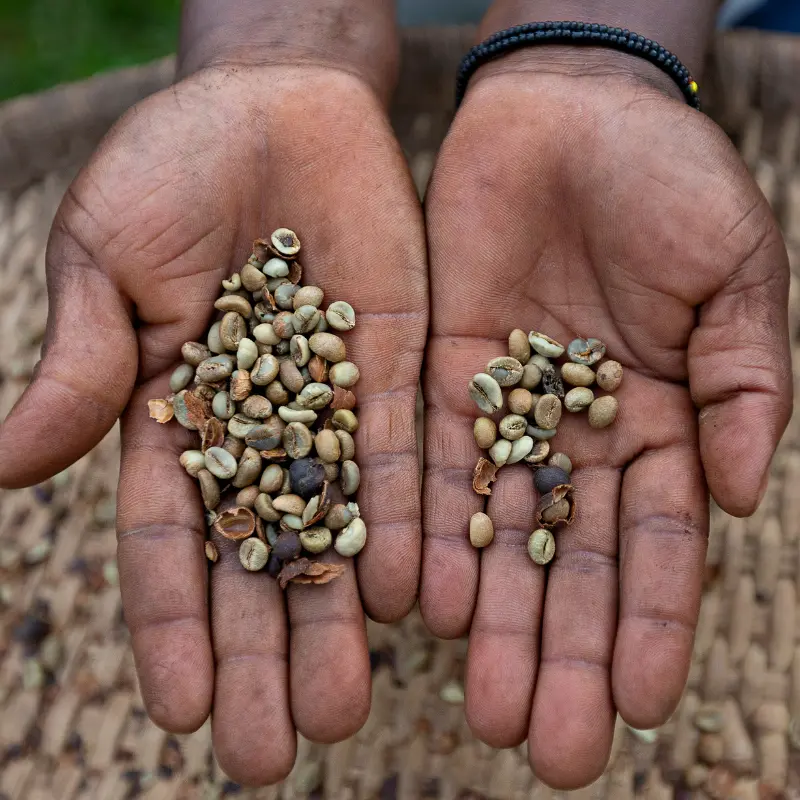
Interesting Facts about Guinean Coffee
Coffee from Guinea only accounts for that much compared to other coffee-producing countries in Africa or Globally. However, this relatively small country’s coffee has left a mark on the global scale. Guinea primarily produces robusta with very few small farms incorporating arabica.
However, the latter’s production is so miniscule that it doesn’t count for much overall production and export. The county’s geographical setting provides better conditions for robusta to thrive. The country grows coffee in a significant number of regions – about 15. These include the Eastern and Western highlands, Simbu region, and Ziama Massif.
The Ziama Massif is the most known region where the prized Ziama Macenta variety is grown. In the coffee world, this robusta varietal is the most flavored and the only one in the country to warrant a geographical location.
The Macenta varietal is the most sought-after robusta variety globally, thanks to its exceptional flavor. The varietal is comparable to the arabica variety due to its ultra smoothness, lack of bitterness, and increased sweetness.
Yet, it still offers the beloved robusta characteristics, such as more caffeine and incredible crema. Unfortunately, the Ziama Macenta robusta coffee varietal suffers from a minimal yield. It doesn’t help that the country also boasts some of the most limiting infrastructure, making accessibility a nightmare.
Note: Don’t confuse the Republic of Guinea with Guinea Bissau to its north or Equatorial Guinea further down its coast.
5. Nigerian Coffee
- Country: Nigeria
- Growing regions: Mambilla (Taraba State), Jos (Plateau State), and Obudu (Cross Rivers), Abia, Osun, Ondo Ekiti, Kogi, Edo, Plateau, Kwara, Ogun, Oyo, Cross Rivers, Adamawa, Benue, Delta, Nasarawa, Niger, Kaduna, Lagos, Rivers, Ebonyi, and Enugu
- Coffee varieties: Robusta and Arabica (Taraba, Plateau and Cross Rivers)
- Profile: Fruity, chocolate, fruity and sweet
- Processing: Natural and wet
- Average production: 5.3 million pounds (less than 0.1% of the total global coffee production)
- Global rank: 47th
6. Ghanaian Coffee
- Country: Ghana
- Growing regions: Ashanti, Brong Ahafo, Eastern, Central, Western, and Volta regions
- Coffee varieties: Robusta
- Profile: Earthy and bitter
- Processing: Natural
- Average production: 4.9 million pounds (less than 0.1% of the total global coffee production)
- Global rank: 48th
7. Burkinabe Coffee
- Country: Burkina Faso
- Coffee varieties: Robusta
- Profile: Earthy and bitter
- Processing: Natural
- Average production: 2.1 million pounds (less than 0.1% of the total global coffee production)
- Global rank: 55th
8. Liberian Coffee
- Country: Liberia
- Growing regions: Central and northern regions – Nimba, Lofa, Bong, Grand Cape Mount, River Gee, and Margibi
- Coffee varieties: 95**%** Robusta and 5% Liberica
- Profile: Earthy and bitter (Robusta)Woody, smoky, and sweet(Liberica)
- Processing: Natural and washed
- Average production: Approx. 800,000 pounds (less than 0.1% of the total global coffee production)
- Global rank: 63rd
Interesting Facts about Liberian Coffee
Liberia and Sierra Leone have massive potential to become some of Africa’s coffee-producing giants. Being native homes to unique varieties, like Liberia or Stenophylla, these countries bear the potential to produce contenders to the single-standing prized varietal, Arabica. Unfortunately, years of civil wars, neglect from governments, and limited education for peasant farmers continue to put these countries at the bottom of the coffee world.
Note: The Sierra Leone Stenophylla or highland varietal has shown initial potential. However, more resources and expertise are required to explore the full potential of this varietal further. According to some experts, this highland coffee has shown the potential to outdo Arabica’s taste.
9. Benin Coffee
- Country: Benin
- Coffee varieties: 99**%** Robusta, 1% Liberica, and less than 1% Excelsa
- Profile: Earthy and bitter (Robusta)Woody, smoky, and sweet(Liberica)
- Processing: Natural
- Average production: Approx. 100,000 pounds (less than 0.1% of the total global coffee production)
- Global rank: 66th
Why West African Coffee Isn’t As Popular As East African Coffee
It may be difficult to pinpoint why West African coffee isn’t as popular as its East African counterparts. However, a few factors may be attributed to this. Compared to East African countries, many West African countries don’t put much effort and investment into coffee as a cash crop and investment.
Moreover, compared to coffee-producing regions in East Africa, many West African countries have experienced political instability with security threats, resource mismanagement, corruption, and different leaders prioritizing other sectors.
Countries such as Rwanda are an excellent example of how countries emerging from wars have managed to spring back. While Rwanda may not be in the top 3 list of producers of coffee in the region, it has shown impressive improvement in just three decades after the grotesque genocide.
But, this was only possible due to its government’s high degree of commitment and organization. Rwanda is also a relatively small country, making planning and implementing its agricultural strategies easier. However, this smaller geographical land also means the potential is limited and cannot be compared to countries with vast lands.
Another reason why West African coffee may not be famous is due to the variety produced in the region. Unlike arabica coffee, the robusta varietal isn’t a popular single-origin coffee option. Therefore, most coffee drinkers haven’t gotten to sample and experience West African coffee.
Therefore, most coffee produced in West Africa is exported as ingredients for products like instant coffee mixes or espresso blends. But, again, robusta coffee doesn’t exactly offer the flavor profiles that one would want to enjoy as a single-origin coffee.
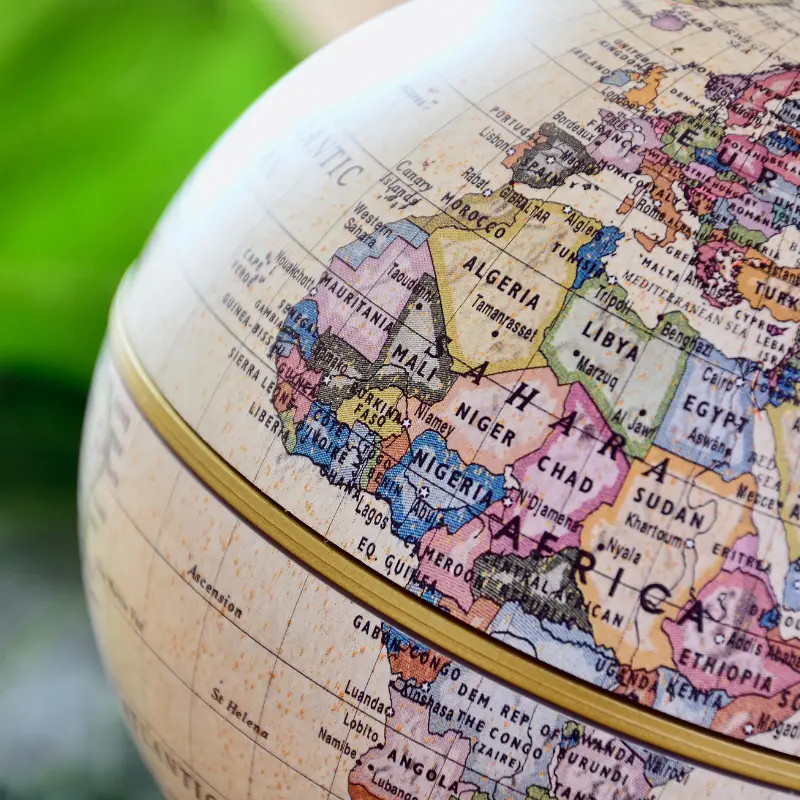
The Future of West African Coffee
Undoubtedly, West Africa contributes its fair share to Africa’s overall coffee exports. Unbeknownst to you, you may even have consumed coffee from this region of the continent numerous times. After all, several Western countries use a good amount of West African coffee for espresso blends, instant coffee mixes, and other coffee-based ingredients. Nonetheless, these coffee-producing countries still hold the potential to do even better.
In the case of Cote d’Ivoire, the coffee industry has seen a pretty interesting pattern. Since its introduction, the country has offered excellent conditions for successful cultivation. Unfortunately, the country’s promising industry was interrupted and offset by civil war for a brief decade or two. As the country has begun to rebuild itself in the past few years, the government has paid more attention to the more promising and controversial cocoa.
This has led many peasant farmers to focus on the more profitable crop. Fortunately, the country’s government has begun to gear its focus on coffee production, investing in educating peasant farmers and more modern harvesting and processing equipment. Fingers crossed, with this approach and more political stability, Cote d’Ivoire can quickly rise back to become one of the global giants in coffee production.
While most West African countries experience similar issues within their respective coffee industries, it would be unfair to point out that each country has its dynamics. Various countries also share their unique challenges and methods with which they choose to interfere.
This explains why some countries may be doing better than their counterparts. Nonetheless, coffee production, apart from the Ivory Coast, may not be the number 1 priority for cash crops in West Africa.
Further, coffee produced in countries with fewer production thresholds continues to decline as fewer interventions are implemented. Most of these countries harvest their coffee from aging trees or coffee that grows in forests.
